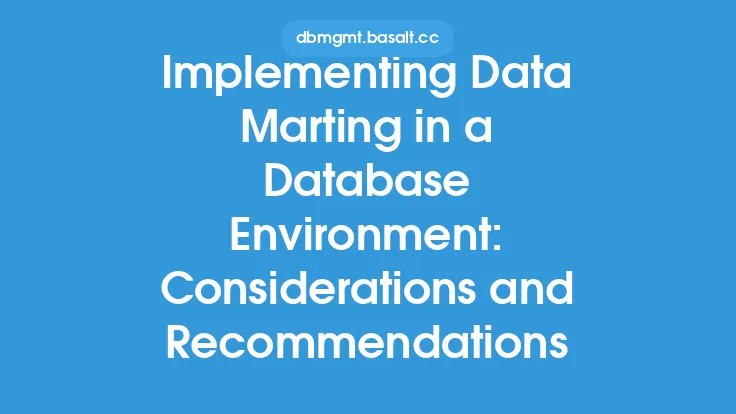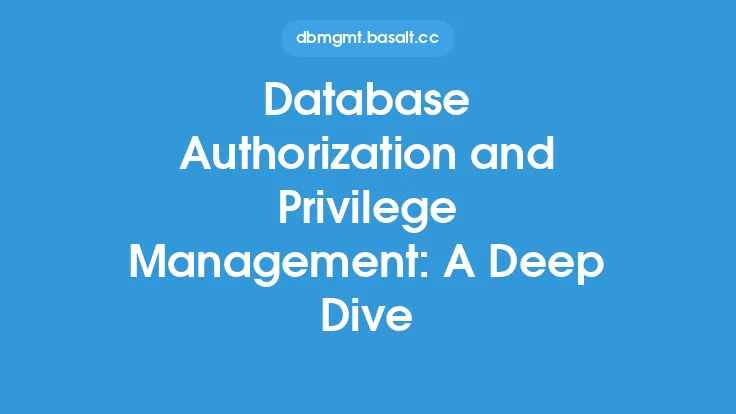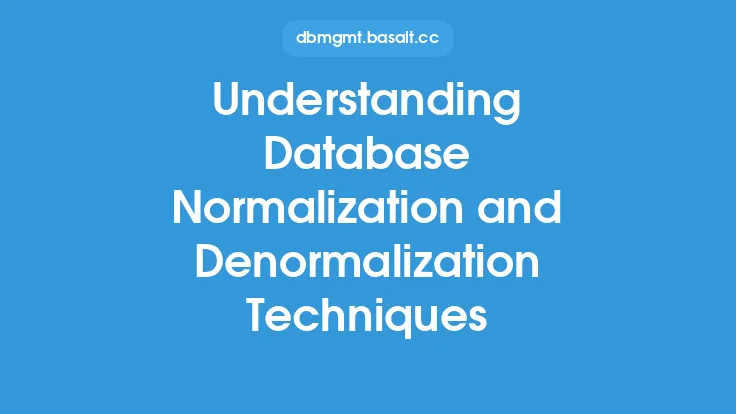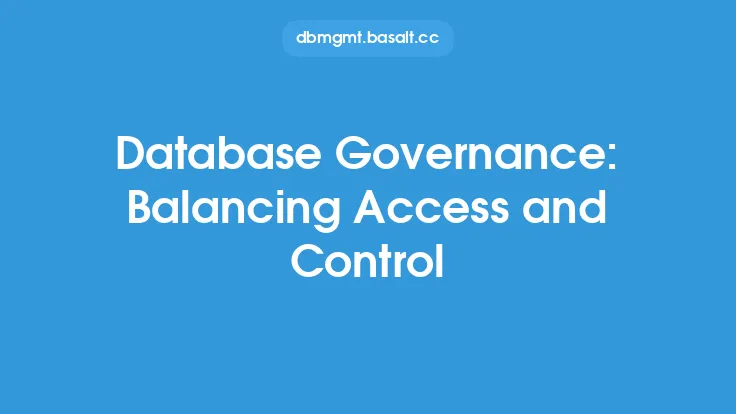Implementing a robust database authorization system is crucial for protecting sensitive data from unauthorized access. Database authorization is the process of granting or denying access to database resources based on a user's identity, role, or privileges. In this article, we will delve into the tips and techniques for implementing database authorization, providing a comprehensive overview of the key concepts, best practices, and technical considerations.
Introduction to Database Authorization
Database authorization is a critical component of database security, as it ensures that only authorized users can access, modify, or delete data. The authorization process involves verifying the identity of users, evaluating their permissions, and granting or denying access to database resources. There are several types of database authorization, including discretionary access control (DAC), mandatory access control (MAC), and role-based access control (RBAC). Each type has its own strengths and weaknesses, and the choice of authorization model depends on the specific requirements of the organization.
Understanding Database Authorization Models
There are several database authorization models, each with its own approach to managing access control. Discretionary access control (DAC) is a model that grants access to database resources based on the discretion of the owner. In DAC, the owner of a resource can grant or deny access to other users, and the access control is based on the user's identity. Mandatory access control (MAC) is a model that grants access to database resources based on a set of rules and policies. In MAC, the access control is based on the sensitivity level of the data and the clearance level of the user. Role-based access control (RBAC) is a model that grants access to database resources based on a user's role within the organization. In RBAC, users are assigned roles, and each role has a set of permissions and privileges.
Implementing Database Authorization
Implementing database authorization involves several steps, including identifying the authorization model, defining roles and privileges, and configuring access control. The first step is to identify the authorization model that best fits the organization's needs. This involves evaluating the types of users, the types of data, and the level of access required. Once the authorization model is identified, the next step is to define roles and privileges. This involves creating roles, assigning privileges to each role, and defining the permissions for each role. The final step is to configure access control, which involves setting up the access control lists, configuring the authentication mechanism, and testing the authorization system.
Configuring Access Control
Configuring access control involves setting up the access control lists, configuring the authentication mechanism, and testing the authorization system. Access control lists (ACLs) are used to define the permissions for each role, and they are typically configured using a combination of SQL commands and database management system (DBMS) tools. The authentication mechanism is used to verify the identity of users, and it can be configured using a variety of methods, including password authentication, Kerberos authentication, and public key infrastructure (PKI) authentication. Testing the authorization system is critical to ensuring that it is working correctly, and it involves verifying that users can access the resources they are authorized to access and that they are denied access to resources they are not authorized to access.
Managing Privileges and Roles
Managing privileges and roles is an ongoing process that involves monitoring user activity, updating roles and privileges, and ensuring that the authorization system is aligned with the organization's security policies. Privileges are the rights granted to users to perform specific actions on database resources, and they can be managed using a variety of tools, including SQL commands and DBMS tools. Roles are the sets of privileges assigned to users, and they can be managed using a variety of tools, including role management tools and identity management systems. Ensuring that the authorization system is aligned with the organization's security policies involves regularly reviewing the authorization system, updating the roles and privileges, and ensuring that the system is compliant with relevant regulations and standards.
Technical Considerations
Implementing database authorization requires careful consideration of several technical factors, including data encryption, network security, and database performance. Data encryption is critical to protecting sensitive data from unauthorized access, and it can be implemented using a variety of methods, including symmetric key encryption and asymmetric key encryption. Network security is critical to protecting the database from network-based attacks, and it can be implemented using a variety of methods, including firewalls, intrusion detection systems, and virtual private networks (VPNs). Database performance is critical to ensuring that the authorization system does not impact the performance of the database, and it can be optimized using a variety of methods, including indexing, caching, and query optimization.
Best Practices for Database Authorization
There are several best practices for database authorization, including using strong passwords, implementing least privilege access, and regularly reviewing the authorization system. Using strong passwords is critical to preventing unauthorized access to the database, and it involves using a combination of uppercase and lowercase letters, numbers, and special characters. Implementing least privilege access involves granting users only the privileges they need to perform their jobs, and it helps to prevent unauthorized access to sensitive data. Regularly reviewing the authorization system involves monitoring user activity, updating roles and privileges, and ensuring that the system is aligned with the organization's security policies.
Common Challenges and Solutions
Implementing database authorization can be challenging, and there are several common challenges and solutions. One common challenge is ensuring that the authorization system is scalable and flexible, and the solution involves using a role-based access control model and implementing a hierarchical role structure. Another common challenge is ensuring that the authorization system is compliant with relevant regulations and standards, and the solution involves regularly reviewing the authorization system and ensuring that it is aligned with the organization's security policies. A third common challenge is ensuring that the authorization system is secure, and the solution involves using strong passwords, implementing least privilege access, and regularly reviewing the authorization system.
Conclusion
Implementing database authorization is a critical component of database security, and it requires careful consideration of several technical and non-technical factors. By understanding the different types of database authorization models, implementing a robust authorization system, and managing privileges and roles, organizations can protect their sensitive data from unauthorized access. Additionally, by following best practices, such as using strong passwords and implementing least privilege access, organizations can ensure that their authorization system is secure and compliant with relevant regulations and standards.





